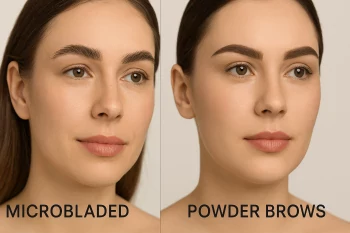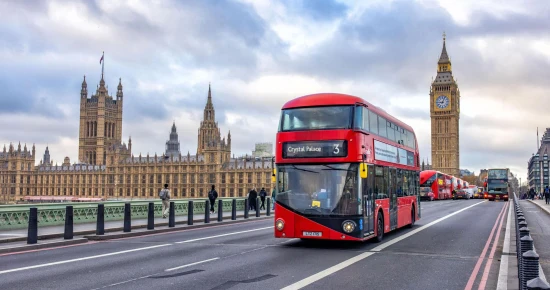Eyebrows frame our face and can dramatically impact our overall appearance. For those struggling with sparse, uneven, or time-consuming brow routines, semi-permanent makeup offers a convenient solution. Two of the most popular options—powder brows and microblading—provide different approaches to achieving fuller, more defined eyebrows. But which technique is right for you?
This comprehensive guide will help you understand the differences between powder brows and microblading, examining the procedures, results, ideal candidates, maintenance requirements, and cost considerations to help you make an informed decision.
Understanding the Techniques: How They Work
Microblading: The Manual Method
Microblading is a semi-permanent tattooing technique that uses a specialized hand tool with tiny needles to create fine, hair-like strokes.
The process:
- The technician manually draws tiny incisions in the skin
- Pigment is deposited into these incisions
- The strokes mimic the appearance of natural eyebrow hairs
- The result is precise, realistic-looking brow hairs
"Microblading creates the illusion of actual hairs," explains Jessica Chen, a certified permanent makeup artist with 8 years of experience. "It's essentially a very controlled, shallow form of tattooing designed specifically for creating natural-looking eyebrows."
Powder Brows: The Shaded Effect
Powder brows (also called ombré brows or microshading) use a different technique to create a softer, filled-in appearance.
The process:
- A machine-powered tool with multiple tiny needles is used
- The tool creates a stippling effect by depositing numerous dots of pigment
- The concentration of dots varies to create a gradient effect
- The result resembles the look of brows filled in with powder makeup
"Powder brows create a soft, diffused effect that mimics the look of perfectly applied eyebrow powder," says Maria Sanchez, an advanced permanent makeup specialist. "The technique involves countless tiny dots of pigment rather than individual strokes."
Visual Results: Appearance Differences
The most significant difference between these techniques lies in the final appearance:
Microblading Results
- Look: Crisp, defined hair-like strokes
- Finish: More natural and textured appearance
- Effect: Creates the illusion of individual brow hairs
- Best for: Those wanting ultra-realistic, natural-looking brows
Powder Brows Results
- Look: Soft, filled-in appearance with a gradient effect
- Finish: More makeup-like, polished appearance
- Effect: Creates a soft-focus, powdered look
- Best for: Those who regularly fill in their brows with powder and want that look 24/7
Many clients find it helpful to consider their everyday makeup routine when deciding. "If you typically use a pencil to draw hair-like strokes, you'll likely prefer microblading. If you use powder to fill in your brows, powder brows will give you that familiar look," advises Taylor Williams, brow specialist and salon owner.
Ideal Candidates: Skin Type Considerations
Your skin type plays a crucial role in determining which technique will work best for you:
Microblading Works Best For:
- Dry to normal skin types
- Firm skin with minimal oil production
- Those without very sensitive skin
- Younger clients with good skin elasticity
Powder Brows Work Best For:
- All skin types, especially oily skin
- Sensitive skin (generally less traumatic than microblading)
- Mature skin with less elasticity
- Those with large pores
- Clients with autoimmune conditions (consult your doctor first)
Dr. Rebecca Lee, a dermatologist specializing in cosmetic procedures, notes: "Microblading can be problematic for oily skin types because the natural oils cause the fine hair strokes to blur over time. Powder brows tend to heal better and last longer on oily skin."
Longevity and Maintenance: Time Investment
Both procedures require touch-ups, but their longevity differs:
Microblading Longevity:
- Initial results last: 12-18 months
- Touch-up recommended: Every 12 months
- Fades: More quickly, especially on oily skin
- Healing process: 4-6 weeks for complete healing
Powder Brows Longevity:
- Initial results last: 2-3 years
- Touch-up recommended: Every 18-24 months
- Fades: More gradually and evenly
- Healing process: 4-6 weeks for complete healing
"Powder brows generally have better longevity because the technique deposits pigment deeper than microblading," explains James Thompson, permanent makeup trainer. "The dot pattern also tends to hold up better as the skin ages and changes."
Pain and Comfort: The Experience
Both procedures involve some discomfort, though experiences vary by individual:
Microblading Comfort:
- Pain level: Moderate (often described as scratching or light cutting sensation)
- Numbing cream: Applied before and during procedure
- Duration: Typically 2-3 hours for initial session
- Sound: Quiet scraping sound
Powder Brows Comfort:
- Pain level: Mild to moderate (often described as vibrating or buzzing sensation)
- Numbing cream: Applied before and during procedure
- Duration: Typically 2-3 hours for initial session
- Sound: Light machine buzzing
"Most clients rate both procedures around 3-5 on a 10-point pain scale," says Emma Davis, who specializes in both techniques. "However, powder brows are often reported as slightly less uncomfortable because there's less cutting of the skin."
Healing Process: What to Expect
The aftercare and healing journeys differ between the two techniques:
Microblading Healing:
- Immediate aftermath: Brows appear 30-40% darker and more defined than final result
- Scabbing: Fine scabs form along each "hair stroke"
- Flaking: Occurs between days 5-10
- Fading: Color looks very light after scabs fall off, then returns
- Complete healing: 4-6 weeks
Powder Brows Healing:
- Immediate aftermath: Brows appear 30-40% darker than final result
- Scabbing: Minimal, with a more uniform scabbing pattern
- Flaking: Typically less dramatic than microblading
- Fading: More gradual and predictable color evolution
- Complete healing: 4-6 weeks
Powder brows typically have a less intense healing process. "The healing journey with powder brows tends to be more forgiving and less dramatic than microblading," notes Sofia Nguyen, cosmetic tattoo artist. "There's less scabbing, which can be more comfortable for clients."
Cost Comparison: Investment Required
Prices vary based on location, artist experience, and salon reputation:
Microblading Average Costs:
- Initial procedure: $400-$800
- Touch-up session: $100-$300
- Yearly maintenance cost: Approximately $150-$300
Powder Brows Average Costs:
- Initial procedure: $450-$800
- Touch-up session: $150-$350
- Yearly maintenance cost: Approximately $100-$200 (due to less frequent touch-ups)
"While the initial investment is similar, powder brows can be more cost-effective long-term due to their extended longevity," explains financial lifestyle advisor Jasmine Rodriguez. "When calculating the cost per day of wear, powder brows often come out ahead."
The Combination Approach: Best of Both Worlds?
Many artists now offer a hybrid technique that combines elements of both procedures:
Combo Brows (Hybrid Brows):
- Technique: Microblading for the front of the brow, powder technique for the arch and tail
- Result: Natural hair-like appearance at the front with more defined, longer-lasting tails
- Best for: Those who want the most customized, dimensional result
- Cost: Typically $50-$150 more than either individual technique
"The combo approach allows us to create the most natural-looking brow possible," says award-winning permanent makeup artist Lucas Martinez. "We get the texture of individual hairs where needed and the definition of powder where appropriate."
Making Your Decision: Key Considerations
To help you choose between powder brows and microblading, ask yourself these questions:
Questions to Consider:
- Skin type: Is my skin dry, normal, or oily?
- Desired look: Do I prefer natural-looking hair strokes or a filled-in powder look?
- Maintenance commitment: Am I willing to return for more frequent touch-ups?
- Age and skin condition: Is my skin mature or do I have any skin conditions?
- Budget: Am I looking for the most cost-effective long-term solution?
- Lifestyle: Do I swim, use exfoliating products, or get regular facials?
What the Experts Say: Professional Recommendations
We consulted several top permanent makeup artists for their expert opinions:
Emily Watson, master trainer with 12 years of experience, recommends: "For clients over 40 or with oily skin, I almost always suggest powder brows. For younger clients with dry skin seeking the most natural look possible, microblading can be magical."
Alex Johnson, celebrity brow artist, advises: "Consider your existing brow situation. If you have some decent natural brow hair and just need filling in, microblading complements what you have. If you're starting with very sparse brows, powder brows can create a more complete framework."
Contraindications: When to Avoid Both Procedures
Neither procedure is suitable for everyone. Avoid both techniques if:
- You're pregnant or breastfeeding
- You have a bleeding disorder or take blood thinners
- You have a history of keloid scarring
- You're currently undergoing chemotherapy
- You have a history of herpes around the treatment area (without preventative medication)
- You've used Accutane within the past 12 months
- You have uncontrolled diabetes
Always consult with healthcare providers before pursuing any semi-permanent makeup procedure if you have health concerns.
Finding the Right Artist: Crucial Selection Criteria
Regardless of which technique you choose, the artist's skill is the most important factor in your results:
What to Look For:
- Portfolio: Extensive before-and-after photos of healed results (not just fresh work)
- Training certificates: Proper certification in your chosen technique
- Reviews: Consistent positive feedback from previous clients
- Consultation approach: Willingness to discuss your concerns and expectations
- Hygiene practices: Clean, professional environment with proper sterilization protocols
- Artistic ability: Natural-looking results that complement facial features
"The difference between a good brow artist and a great one isn't just technical skill—it's their understanding of facial proportions and their ability to customize the shape to each individual face," advises master trainer Olivia Campbell.
The Consultation Process: What to Expect
A thorough consultation should precede either procedure:
During a Professional Consultation:
- Discussion of goals: Your desired shape, color, and thickness
- Face mapping: Drawing potential shapes based on your facial structure
- Color selection: Choosing pigments that complement your skin tone and hair color
- Technique recommendation: Professional assessment of which method suits your needs
- Health screening: Review of any conditions that might affect results
- Realistic expectations: Clear communication about what can be achieved
"A consultation isn't just for the client—it's for the artist too," explains Sophia Miller, who specializes in permanent makeup corrections. "It allows us to determine if we can achieve what you want and if you're a good candidate for the procedure."
Final Verdict: Making Your Choice
Both powder brows and microblading offer excellent solutions for different needs:
Choose Microblading If:
- You want the most natural, hair-like appearance
- You have dry to normal skin
- You don't mind more frequent touch-ups
- You have good skin elasticity
- You currently use a pencil to create hair-like strokes
Choose Powder Brows If:
- You want a filled-in, makeup look
- You have oily skin
- You prefer longer-lasting results
- You have mature or sensitive skin
- You currently use powder products to fill your brows
Remember that your lifestyle, skin type, and maintenance preferences should guide your decision more than trends or what looks good on someone else.
Frequently Asked Questions
Q: Can I get microblading or powder brows if I have no eyebrow hair at all? A: Yes. Both techniques can create the illusion of brows where little to no hair exists. Powder brows often create a more complete look for those with very sparse brows.
Q: Will I still need to use brow products after getting either procedure? A: Most clients find they don't need additional products after healing is complete. However, some choose to add definition for special occasions.
Q: How do I prepare for my appointment? A: Avoid blood thinners (with doctor's approval), alcohol, caffeine, and retinol products before your appointment. Come with clean brows and a clear idea of your desired shape.
Q: What about removal if I don't like the results? A: Both techniques can be removed using laser, saline, or glycolic acid methods, though this can be costly and require multiple sessions. This is why choosing a skilled artist is crucial.
Q: Do powder brows or microblading work better for covering scars? A: Powder brows typically provide better coverage for significant scarring, while microblading can work well for minor scars.
By weighing these factors carefully and consulting with experienced professionals, you can determine whether powder brows or microblading will best achieve your eyebrow goals, providing you with years of wake-up-and-go convenience and enhanced facial framing.





